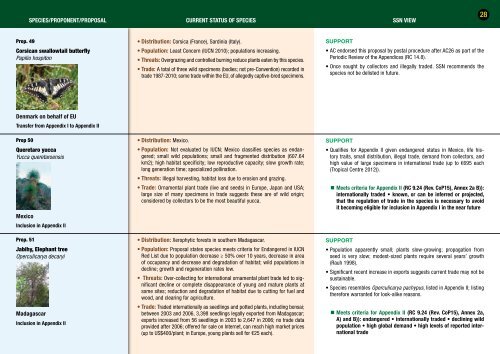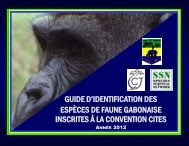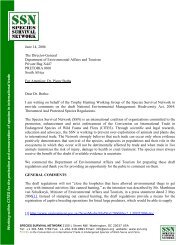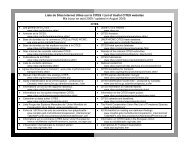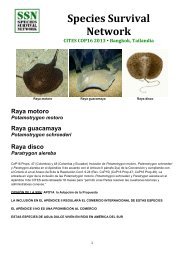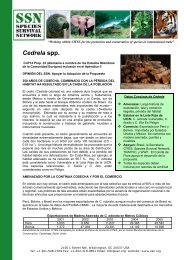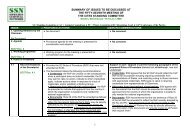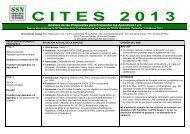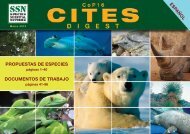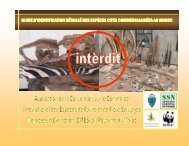CITES CoP16 Digest - Species Survival Network
CITES CoP16 Digest - Species Survival Network
CITES CoP16 Digest - Species Survival Network
Create successful ePaper yourself
Turn your PDF publications into a flip-book with our unique Google optimized e-Paper software.
SPECIES/PROPONENT/PROPOSAL CURRENT STATUS OF SPECIES SSN VIEW<br />
28<br />
Prop. 49<br />
Corsican swallowtail butterfly<br />
Papilio hospiton<br />
• Distribution: Corsica (France), Sardinia (Italy).<br />
• Population: Least Concern (IUCN 2010); populations increasing.<br />
• Threats: Overgrazing and controlled burning reduce plants eaten by this species.<br />
• Trade: A total of three wild specimens (bodies; not pre-Convention) recorded in<br />
trade 1987-2010; some trade within the EU, of allegedly captive-bred specimens.<br />
SUPPORT<br />
• AC endorsed this proposal by postal procedure after AC26 as part of the<br />
Periodic Review of the Appendices (RC 14.8).<br />
• Once sought by collectors and illegally traded. SSN recommends the<br />
species not be delisted in future.<br />
Denmark on behalf of EU<br />
Transfer from Appendix I to Appendix II<br />
Prop 50<br />
Queretaro yucca<br />
Yucca queretaroensis<br />
Mexico<br />
Inclusion in Appendix II<br />
Prop. 51<br />
Jabihy, Elephant tree<br />
Operculicarya decaryi<br />
Madagascar<br />
Inclusion in Appendix II<br />
• Distribution: Mexico.<br />
• Population: Not evaluated by IUCN; Mexico classifies species as endangered;<br />
small wild populations; small and fragmented distribution (607.64<br />
km2); high habitat specificity; low reproductive capacity; slow growth rate;<br />
long generation time; specialized pollination.<br />
• Threats: Illegal harvesting, habitat loss due to erosion and grazing.<br />
• Trade: Ornamental plant trade (live and seeds) in Europe, Japan and USA;<br />
large size of many specimens in trade suggests these are of wild origin;<br />
considered by collectors to be the most beautiful yucca.<br />
• Distribution: Xerophytic forests in southern Madagascar.<br />
• Population: Proposal states species meets criteria for Endangered in IUCN<br />
Red List due to population decrease ≥ 50% over 10 years, decrease in area<br />
of occupancy and decrease and degradation of habitat; wild populations in<br />
decline; growth and regeneration rates low.<br />
• Threats: Over-collecting for international ornamental plant trade led to significant<br />
decline or complete disappearance of young and mature plants at<br />
some sites; reduction and degradation of habitat due to cutting for fuel and<br />
wood, and clearing for agriculture.<br />
• Trade: Traded internationally as seedlings and potted plants, including bonsai;<br />
between 2003 and 2006, 3,398 seedlings legally exported from Madagascar;<br />
exports increased from 56 seedlings in 2003 to 2,647 in 2006; no trade data<br />
provided after 2006; offered for sale on Internet, can reach high market prices<br />
(up to US$400/plant; in Europe, young plants sell for €25 each).<br />
SUPPORT<br />
• Qualifies for Appendix II given endangered status in Mexico, life history<br />
traits, small distribution, illegal trade, demand from collectors, and<br />
high value of large specimens in international trade (up to €695 each<br />
(Tropical Centre 2012)).<br />
• Meets criteria for Appendix II (RC 9.24 (Rev. CoP15), Annex 2a B)):<br />
internationally traded • known, or can be inferred or projected,<br />
that the regulation of trade in the species is necessary to avoid<br />
it becoming eligible for inclusion in Appendix I in the near future<br />
SUPPORT<br />
• Population apparently small; plants slow-growing; propagation from<br />
seed is very slow; modest-sized plants require several years’ growth<br />
(Rauh 1998).<br />
• Significant recent increase in exports suggests current trade may not be<br />
sustainable.<br />
• <strong>Species</strong> resembles Operculicarya pachypus, listed in Appendix II; listing<br />
therefore warranted for look-alike reasons.<br />
• Meets criteria for Appendix II (RC 9.24 (Rev. CoP15), Annex 2a,<br />
A) and B)): endangered • internationally traded • declining wild<br />
population • high global demand • high levels of reported international<br />
trade


